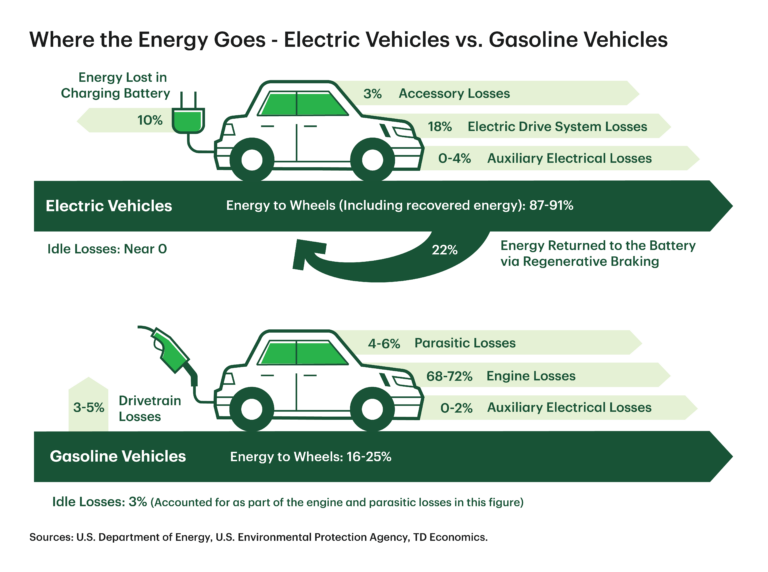Electric vs. Gasoline Vehicles: A Canadian Lifecycle Emissions Comparison
Battery electric vehicles (BEVs) are increasingly seen as a key technology for reducing greenhouse gas emissions in the transportation sector. But are they truly better for the environment, considering the emissions tied to battery production and electricity generation? To answer this, we need a comprehensive view of lifecycle emissions, factoring in everything from manufacturing to fuel production and vehicle disposal. This analysis explores the lifecycle emissions of electric versus gasoline vehicles in Canada, considering various factors including electricity grid composition and vehicle efficiency.
Key Findings
- BEVs have significantly lower lifecycle emissions than gasoline vehicles. While initial battery production has a higher carbon footprint, the massive fuel-related emissions of gasoline vehicles drive the emissions gap.
- Plug-in hybrid electric vehicles (PHEVs) also offer lower emissions, though the savings are smaller than those of BEVs and depend heavily on electric versus gasoline driving.
- Emissions benefits of BEVs vary by region, depending on the carbon intensity of the local electricity supply. Even in areas reliant on fossil fuels, BEVs still use less energy than gasoline vehicles.
- Availability and affordability of EVs are crucial. The pace of transition to EVs and emissions reductions could be slowed by a lack of affordable models and the possible rollback of rebate programs.
The Lifecycle Emissions Perspective
Lifecycle emissions encompass a full range of emissions sources associated with a vehicle, from its creation to its ultimate disposal. This includes:
- Vehicle Cycle Emissions: These cover the manufacturing process, including raw material extraction and component production, along with maintenance and end-of-life disposal.
- Fuel Cycle Emissions: These comprise the emissions from fuel production and use—whether electricity, gasoline, or diesel.
For 2024 model year vehicles, BEVs have higher vehicle cycle emissions, primarily due to battery production, while fuel cycle emissions are greater for internal combustion engine vehicles (ICEVs). However, the greater fuel-related emissions of ICEVs mean their overall lifetime emissions generally surpass those of electric vehicles.
Battery Production Emissions
Lithium-ion batteries are a major factor. Battery production results in vehicle cycle emissions about twice as high for BEVs when compared to gasoline vehicles. The extraction and refining of minerals like lithium, nickel, and cobalt is energy-intensive and the high temperatures needed for battery chemical component manufacturing typically involves burning fossil fuels.
Battery production emissions largely depend on the energy mix at the manufacturing location. For example, batteries made in Sweden have significantly lower emissions than those in China.”,
This difference is largely due to China’s heavy reliance on coal for electricity. However, this also means that emissions from battery manufacturing are likely to fall as cleaner energy sources increase their market share.
Energy Efficiency
BEVs have a clear advantage in energy efficiency. Only around 16-25% of the energy in gasoline is used to move an ICEV, while 87-91% of electricity powers to propel a BEV. Consequently, mile for mile, ICEVs consume more fuel and generate more emissions.
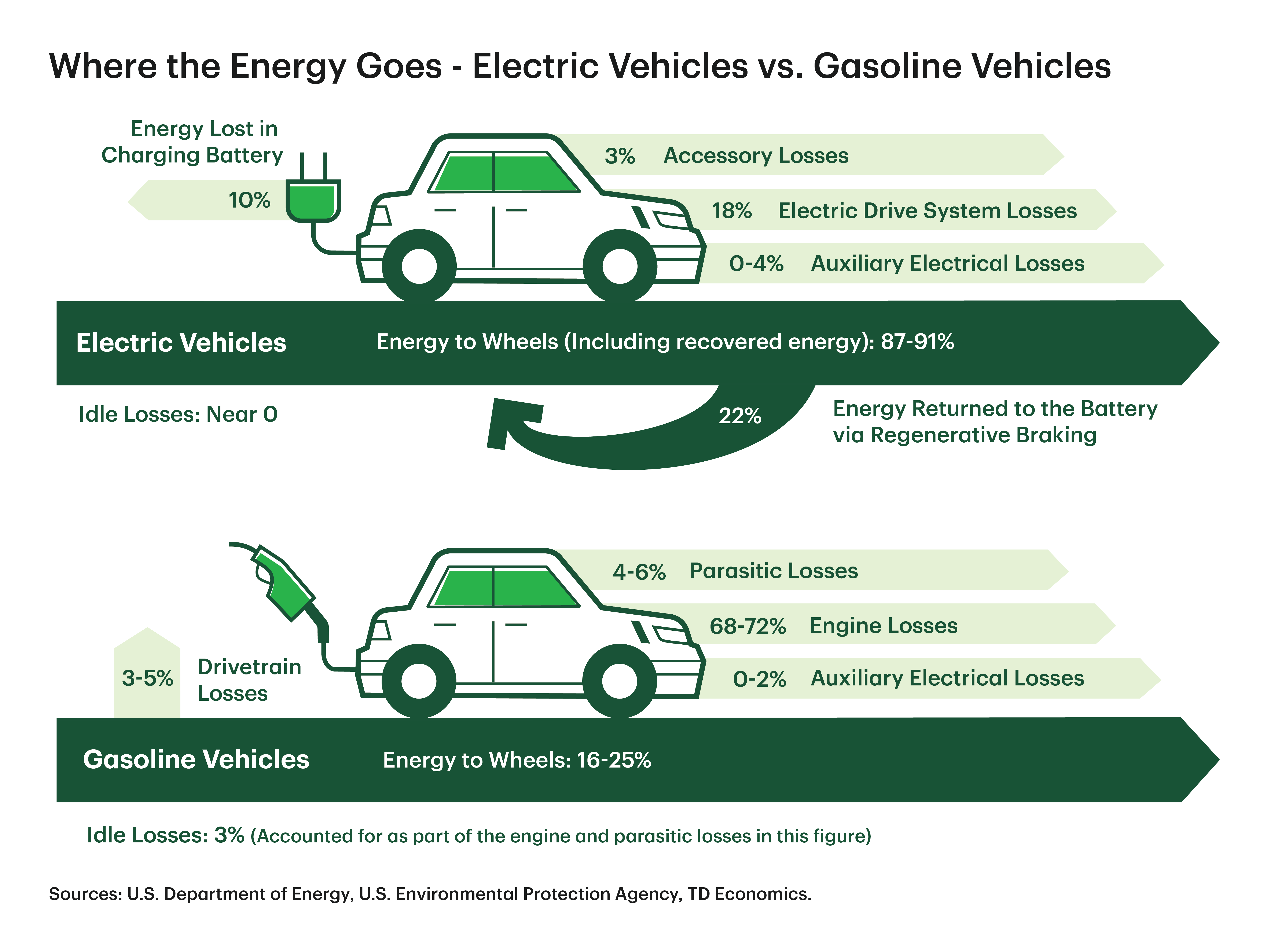
For example, a standard gasoline SUV might use 6.7-21.7 liters of gasoline per 100 km, whereas the electric version uses 20.9-44.6 kWh, which is equivalent to 2.3-5 liters of gasoline in terms of energy content. On average, a gasoline SUV uses about four times as much energy per distance traveled as its electric counterpart.
Regional Variations and Electricity Grids
Electric vehicles also benefit from the lower emissions intensity of electricity generation compared to gasoline in most of Canada. Using a national average, grid electricity emissions are 61% lower than those of gasoline. This advantage ranges from 20% to 93% in provinces and territories with cleaner electricity sources.
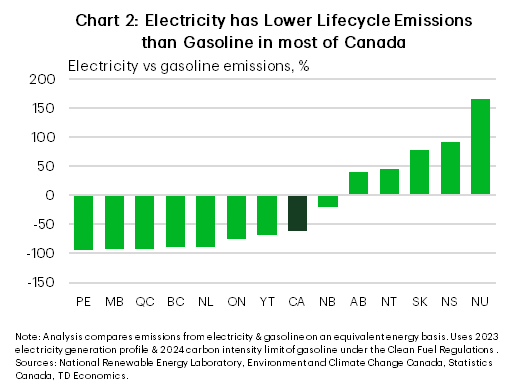
However, some jurisdictions have electricity grids that are more emissions-intensive than gasoline. Even in these regions, BEVs often have lower lifetime emissions because of their superior operational energy efficiency. The cleaner the electricity grid, the greater the benefit of electric vehicle use. Furthermore, the emissions benefits of BEVs will rise over time as the electricity grid is decarbonized.
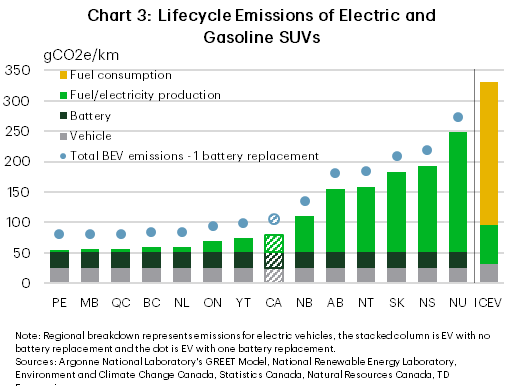
In regions like Quebec, Manitoba, and British Columbia, where hydroelectric power dominates, the emissions savings are in the 78-83% range when using an electric SUV. Even in Ontario, with a mix of nuclear, hydro, and renewables, the emissions savings are around 80%. In provinces with more carbon-intensive electricity grids, such as Alberta, electric vehicles still offer substantial emissions reductions due to their greater energy efficiency.
Plug-in Hybrid Considerations
PHEVs also reduce emissions, but not as significantly as BEVs . The emissions savings of PHEVs depend on what percentage of miles are driven in electric mode versus gasoline mode.
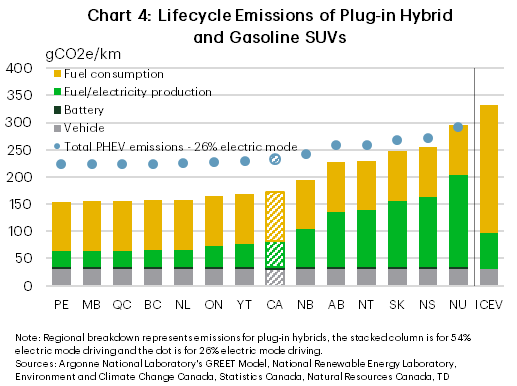
For example, if a PHEV SUV is driven in electric mode 54% of the time, lifecycle emissions can be reduced by 11-53% on average relative to a comparable ICEV, depending on the region. If the electric mode is used less frequently (e.g., 26% of the time), emissions savings are smaller, averaging 12-33%.
Affordability and the Future of EVs
The cost of electric vehicles is an essential factor. Across price ranges where electric and gasoline vehicles overlap, most electric models exhibit lower lifecycle emissions. Still, consumers are often limited by the dearth of affordable electric models on the market.
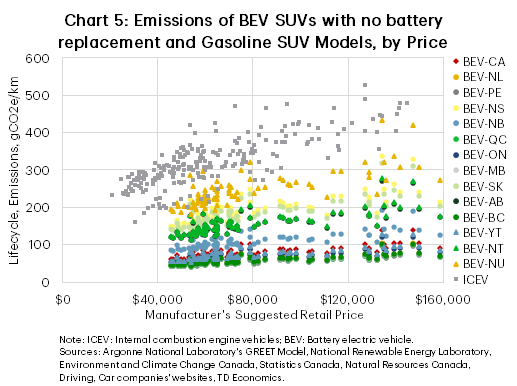
The recent end of the federal EV rebate program could hinder adoption, especially for lower-income buyers. The expansion of affordable electric models is crucial to broaden accessibility and maximize the environmental advantages of electric vehicles.
Conclusion
Battery electric vehicles represent a significant tool in decarbonizing the transportation sector by offering notable emissions savings compared to gasoline vehicles. The benefits are consistent, even in areas with more carbon-intensive electricity generation. PHEVs also contribute, but to a smaller degree than BEVs, and are most effective when driven primarily using electric power.
To encourage the transition, there’s a need for more affordable BEV models and for the reinstatement or extension of rebate programs to assist lower-income buyers. This is paramount to widening access to EVs, and realizing the full potential of a zero-emission transportation future.



